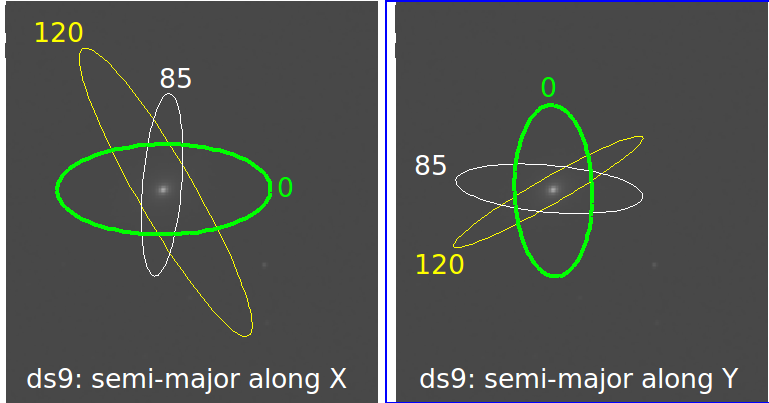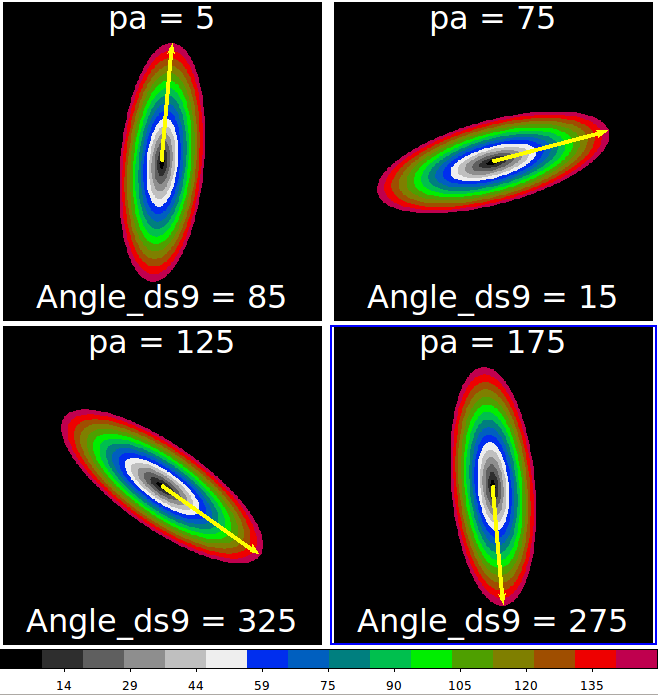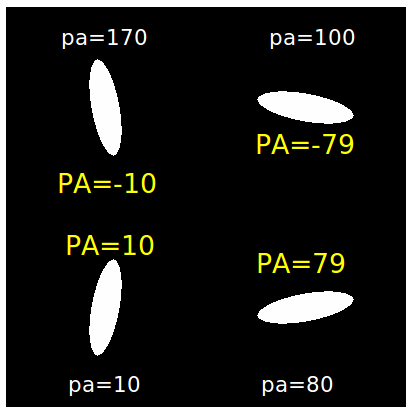Ellipse Things
It seems that everything that uses an ellipse manages to follow
a different convention for how the position angle is represented.
I cover a lot of different thinsg in the present doc, but as I
determine the ellipse position angle conventions I use in
different tasks, I document them here at the top.
ds9 ellipse regions
- Semi-major axis on X, angles are measured from +X axis
- Semi-major axis on Y, angles are measured from +Y axis
- Angles are measured COUNTER-CLOCKWISE
- Angles cover range 0 to 360
 |
|
FIGURE 0: Because I use ds9 ellipse markers for a lot of things I made
this figure to illustrate how the zero position of a ds9 ellipse region
depended on the axis on which the semi-major (long) axis of the
ellipse is set. The user might use the mouse to adjust the axis
ratio by putting the long axis along the X or Y axis. Then, he/she
will rotate the ellipse to desired position angle. In the above examples we
see examples of the long axis being set on the X axis (left) and on
the Y axis (right). In both cases, the position angle is measured as
POSITIVE in the COUNTER-CLOCKWISE sense. It should be noteed that NEGATIVE
angles are not used (if you type angle=-120 into the Ellispe box, then it
adjusts to be angle=360-120=240).
|
ellradius.sh == make an elliptical aperture radius map
- Angles are measured from +Y (vertical)
- Positive angles are measured CLOCKWISE
- Negative angles are measured COUNTER-CLOCKWISE
The pa values in Figure 1 below show examples of
different position angle settings used in ellradius.sh runs.
GALPHOT ellipse fitter (ellipse.f is a library subroutine)
- Semi-major axis is set on +Y axis (vertical)
- Angles are measured from +Y axis
- Positive angles are measured CLOCKWISE
- Negative angles are measured COUNTER-CLOCKWISE
- Negative angles cover range 0 to -90
- Positive angles cover range 0 to +90
The PA values in Figure 2 below show examples of
different position angle values from ellipse.f runs.
Ellipse Angles with Test_Data_for_Codes/T_runs/ellradius/ex0/RUN
Below I describe some rather convoluted scripts (for Test_Data_for_Codes)
They demonstrate the ellipse parameter conventions used
with my fortran ellipse fitting routine ellipse.f (this routine
usually resides in a library like SCOLIB or OTWLIB).
Below we consider an example of a multiple task script
that I used to produce test images of ellipse figures. I wanted
to confirm that my ellipse fitting routine was finding the position
angle correctly. In the example below, I use the ellradius
procedure to make the test imges. I used the thresh and
STACKER routines to make a final test images. I then processed
this image through the point of momcat to get my answers:
% pwd
...../Test_Data_for_Codes/T_runs/ellradius/ex0/RUN
As an immedaite example, I show a figure below that illustrates
angle values used by the ds9 ellipse regions (Angle_ds9) and the
position angle used by my elliptical radius image code named
ellradius (pa in the figure below). As fate would have it, the
ellipse.f routine would represent the major axis position angle
with yet another convention. In the script below, I show I how
to generate a useful image that demos the angle convention for
ellipse.f (as it is used on the moments-based catalog routine
momcat.sh).
 |
|
FIGURE 1: Radius maps from ellradius. In every case above an ellipse
with b/a=0.35 and a semi-major axis length of asemi=150 pixels was
generated with different pa (Position Angle) values. The value of
each pixel in the output radius map (rad.fits) is the radius in
the deprojected (original) circle. The color scale at the bottom of the
figure shows that the maximum radius values run from 0 to about 150
pixels. The pa values are measured from the POSITIVE-Y axis in a
CLOCKWISE direction. For comparison we also show the corresponding
ds9 Angle value used to plot a vector representing the semi-major
axis of the projected ellipse.
|
Ellipse Angles with Test_Data_for_Codes/T_runs/ellradius/ex0/RUN
A fairly long routine called "RUN" uses various image processing
routines to generate elliptical shapes and fit their contours
with ellipses. The full code can be viewed
HERE.
% RUN 10 80 100 170
The ellipse results (from just_ellipse.list):
X Y A_semi B/A PA
100 100 45 0.266 10
300 100 45 0.267 79
100 299 45 0.266 -10
300 299 45 0.267 -79
% ds9 PA_test.fits &
Manually load legend.reg
The table printed at the end of the run tells me the
PA values derived by ellfit.f in each case. I use the
X,Y values in the table to identify the respective
ellipse figure when I view the ds9 image of the final
FITS file called PA_test.fits. From this little exercise
one can see that the ellfit.f uses the following position
angle rules:
* Angles are measured from +Y (vertical)
* Positive angles are measured CLOCKWISE
* Negative angles are measured COUNTER-CLOCKWISE
 |
|
FIGURE 2: The small print "pa=" values show the position angle used by the
ellradius.sh routine to generate the ellipse. The larger text "PA="
values (in yellow) show the fitted position angle derived with the
fortran routine ellipse.f (in OTWLIB).
|
Back to TEST DATA page
Back to SCO CODES page


